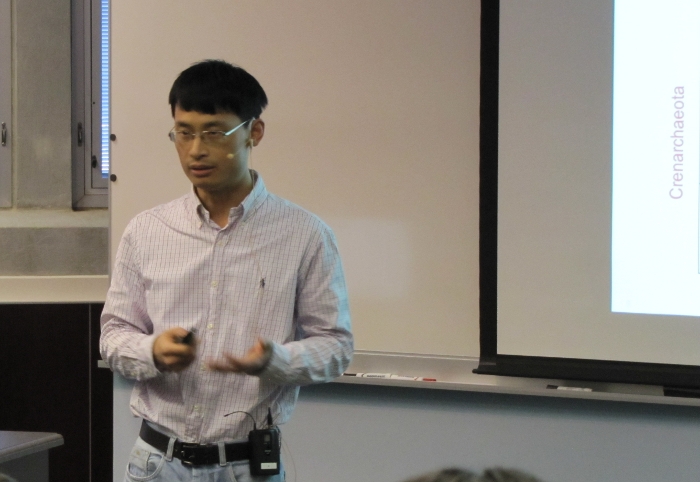NIMBioS Seminar Series
In conjunction with the interdisciplinary activities of the National Institute for Mathematical and Biological Synthesis (NIMBioS), a seminar series on topics in mathematical biology will be hosted at NIMBioS every other Tuesday at 3:30 p.m. (unless otherwise noted) in the Hallam Auditorium, Room 206, Claxton Building, 1122 Volunteer Blvd. Seminar speakers will focus on their research initiatives at the interface of mathematics and many areas of the life sciences. Light refreshments will be served in Room 205 beginning 30 minutes before each talk. Faculty and students from across the UT community are welcome to join us.
Speaker:
Dr. Chongle Pan, Computer Science and Mathematics Division, Oak Ridge National Laboratory; Microbiology, Univ. of Tennessee
Time/Date: Tuesday, January 19, 2016, 3:30-5:00 p.m.*
Location:
Room 206, Claxton Building, 1122 Volunteer Blvd.
Topic:
Characterization of microbial evolution and physiology using big omics data
Abstract:
Genomics and other -omics analyses can provide large amounts of data to elucidate the evolution and physiology of microorganisms. A functional phylogenomics study was performed to characterize the evolution of metabolic functions in Bacteria and Archaea. A total of 14,727 GenBank prokaryotic genomes were re-annotated using a new protein family database, UniFam, to obtain consistent functional annotations. The consistency between the distribution of metabolic pathways in genomes and the phylogenetic tree of genomes was measured using parsimony scores and retention indices. Function-phylogeny correlation identified a set of clade-specific metabolic pathways with low parsimony scores. Many other metabolic pathways were sparsely dispersed across many clades with high parsimony scores, which indicated their frequent horizontal gene transfers. Many plant-associated fungi host symbiotic endobacteria with reduced genomes. We integrated proteomics and metabolomics to characterize the endobacterium Candidatus Glomeribacter sp. and the root endophytic fungus Mortierella elongata. The endobacterium likely extracted malate from the fungal host as the primary carbon substrate for energy production and biosynthesis. Further, nitrogen limitation significantly perturbed the carbon and nitrogen flows in the fungal metabolic network. M. elongata regulated many pathways by concordant changes on enzyme abundances, post-translational modifications, reactant concentrations, and allosteric effectors. Such multimodal regulations may be a general mechanism for metabolic modulation.
Chongle Pan is a staff scientist in the Computer Science and Mathematics Division of Oak Ridge National Laboratory and a joint associate professor in the Department of Microbiology of the University of Tennessee. He is interested in the characterization of microbial communities using metagenomics and metaproteomics. His computational research is focused on development of new algorithms for analysis of big omics data using high-performance computing. His work enabled community proteogenomics studies that elucidated metabolic activities of microbial communities in ecosystems of relevance to global carbon cycling and human health.
*Join us for refreshments at 3 p.m.
Seminar Flyer (pdf)
![]() Watch seminar online. This video was streamed live. Live-streamed seminars are archived for later viewing on NIMBioS' YouTube channel.
Watch seminar online. This video was streamed live. Live-streamed seminars are archived for later viewing on NIMBioS' YouTube channel.
For more information about this and other NIMBioS Seminars, visit /seminars.

NIMBioS
1122 Volunteer Blvd., Suite 106
University of Tennessee
Knoxville,
TN 37996-3410
PH: (865) 974-9334
FAX: (865) 974-9461
Contact NIMBioS



